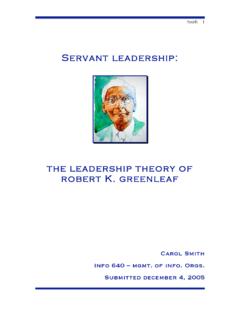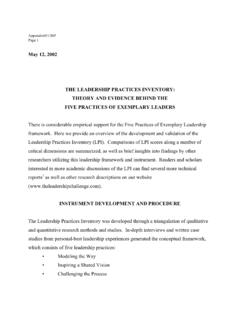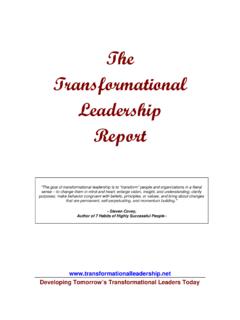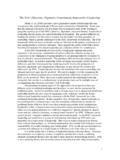Transcription of Leadership theory and educational outcomes: The case of ...
1 1 Leadership theory and educational outcomes: The case of distributed and transformational Leadership Maria Eliophotou Menon Department of Education, University of Cyprus, PO Box 20537 1678 Nicosia Cyprus Tel.: 357-892944 Fax: 357-22894488 E-mail: 2 Leadership theory and educational outcomes: The case of distributed and transformational Leadership Abstract The effect of school Leadership on educational outcomes has been widely debated in recent decades. Only a small fraction of available studies on school Leadership deal with its effects on specific educational outcomes. The paper aims to provide an overview of research on the effects of two contemporary Leadership theories (distributed Leadership and transformational Leadership ) on educational outcomes.
2 The theoretical basis for each theory is discussed, with reference to different approaches to the conceptualisation of distributed and transformational perspectives in the literature. Moreover, the paper attempts to analyse the main limitations of the two theories and to assess their contribution to the investigation of the effects of Leadership on educational outcomes. The overview of evidence on the effects of distributed and transformational Leadership is used as the basis for suggestions and recommendations in relation to future research. Keywords: Distributed Leadership , transformational Leadership , educational outcomes Introduction In recent decades, the literature on educational administration has focused on the study of Leadership concepts, models, and practices.
3 Despite the abundance of studies on educational Leadership , very few have attempted to measure the effect of school Leadership on educational outcomes. Robinson (2008) draws attention to the fact that less than 30 of the published studies of educational Leadership , have investigated the link between Leadership and student outcomes. The limited research on the topic does not allow for the informed promotion and/or adoption of Leadership models and practices in education in that policy makers lack the evidence that can serve as the basis for the support of specific approaches to Leadership . The paper aims to provide an overview of research on the effects of two contemporary Leadership theories (distributed Leadership and transformational Leadership ) on educational outcomes.
4 It will thus provide a review of international literature on the two theories in relation to their effects on key educational outcomes. It will mainly focus on student outcome variables such as student performance even though it will also address the link between Leadership practices and teacher-related outcomes ( teachers organisational commitment). Moreover, an attempt is made to critically evaluate the contribution of the two theories to educational improvement through an examination of their limitations and weaknesses. In this context, the paper aims to provide a synthesis of available research, which will serve as the basis for conclusions regarding the contribution of the two theories to the investigation of the effects of Leadership on educational outcomes.
5 The paper begins with an overview of distributed and transformational Leadership as they appear in the educational administration literature. It then proceeds to investigate their effects on key outcomes based on a review of relevant research. Finally, it examines the limitations of the two theories and discusses implications for future research. 3 Distributed and Transformational Leadership : The theory Distributed Leadership The term distributed Leadership is believed to have been used for the first time by Gibb (1954), an Australian psychologist, who drew attention to the dynamics of influence processes as they impact on the work of different groups.
6 Gibb suggests that Leadership should not be viewed as the monopoly of the individual but rather as shared functions among individuals. The belief that Leadership is best considered a group quality has gradually gained widespread acceptance in the field of education. Harris, Leithwood, Day, Sammons and Hopkins (2007) describe distributed Leadership as the Leadership idea of the moment , while Gronn (2000) refers to this concept as the new kid on the block . A review of the educational administration literature suggests that the concept of distributed Leadership has been embraced with enthusiasm by educational researchers and scholars.
7 Two popular interpretations of distributed Leadership theory are found in the work of Peter Gronn and James Spillane. Spillane, Halverson and Diamond (2004) refer to Leadership as distributed practice. Spillane (2006) draws on work in cognitive psychology emphasising distributed cognition and the role of the social context as an influence on human learning and behaviour. In organisations, both formal and informal groups are believed to constantly interact, resulting in shared patterns of communication, learning and action. In this context, distributed Leadership emerges as a shared practice by individuals seeking to address organisational issues and problems.
8 At the school, teachers may be considered to engage in distributed Leadership practice when, for instance, they collaborate in an attempt to take action regarding specific problems. A distributed perspective can be viewed as a conceptual framework for investigating school Leadership and management. It involves two aspects: the leader-plus aspect (who) and the practice aspect (how). The leader-plus aspect acknowledges that the work of leading schools involves multiple individuals and is not restricted to those at the top of the organisational hierarchy or those assigned formal Leadership duties. In this framework, Leadership practice is the outcome of the interaction of school leaders, followers, and their situations (Spillane, Hunt, & Healy, 2008).
9 Consequently, the distributed view of Leadership is responsible from a shift of focus in that the emphasis is no longer on school principals and other formal and informal leaders but on a web of stakeholders and their situations (Spillane & Diamond, 2007). Gronn (2002a) suggests that the distributed perspective introduces a dynamic understanding of Leadership according to which Leadership is no longer individually conceived. He argues against traditional approaches of Leadership based on the assumption of the superiority of the leader and the dependence of followers on leaders. A new perspective of Leadership is proposed, grounded in a theory of action.
10 According to Gronn (2000, p. 325), a distributed view of organisational activities and tasks is linked to a new form of the division of labour in organisations, in which the authorship and the scope of the activities to be performed have to be redefined to encompass pluralities of agents whose actions dovetail or mesh to express new patterns of interdependent relations. Gronn (2002b) distinguishes between two forms of distributed Leadership , namely, additive and holistic . Additive forms of distribution refer an uncoordinated Leadership pattern, in which many different people may engage in Leadership practices without taking into account the Leadership activities of others in the organisation.









